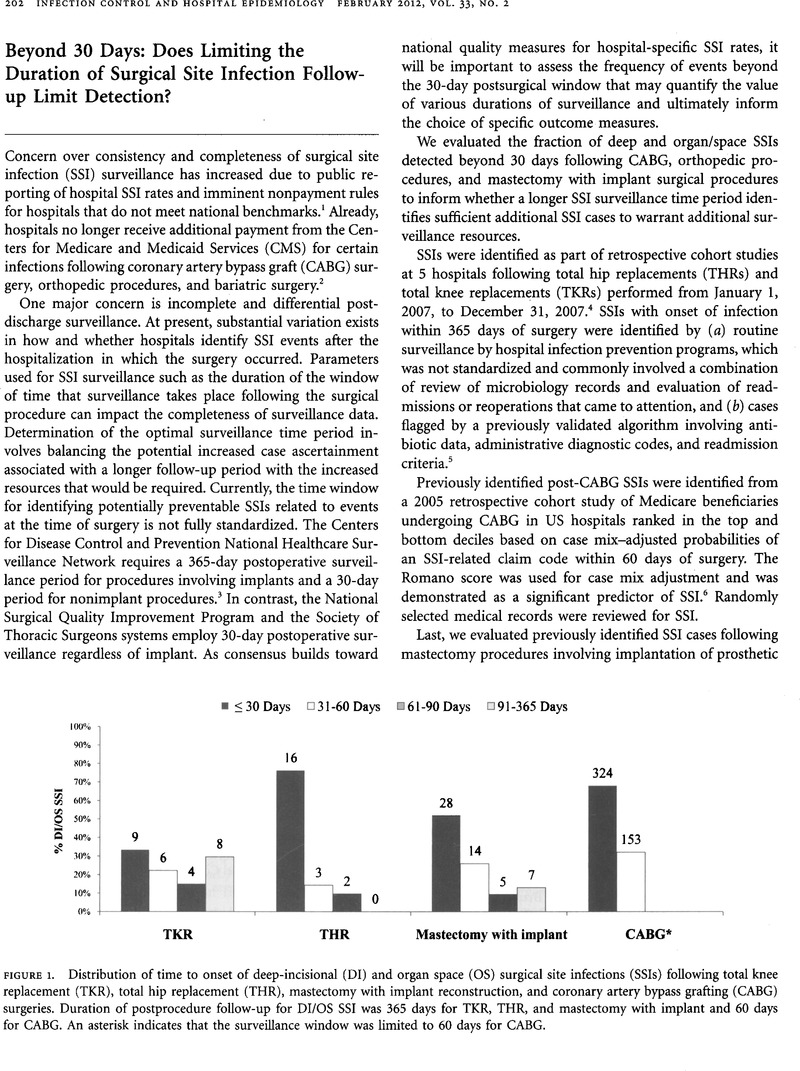Crossref Citations
This article has been cited by the following publications. This list is generated based on data provided by Crossref.
Bryce, Elizabeth
and
Forrester, Leslie
2012.
How Long Is Long Enough? Determining the Optimal Surgical Site Infection Surveillance Period.
Infection Control & Hospital Epidemiology,
Vol. 33,
Issue. 11,
p.
1178.
King, C.
Aylin, P.
Chukwuemeka, A.
Anderson, J.
and
Holmes, A.
2013.
Assessing data sources for sustainable and continuous surveillance: surgical site infections following coronary artery bypass grafts in England.
Journal of Hospital Infection,
Vol. 84,
Issue. 4,
p.
305.
Gibson, Angela
Tevis, Sarah
and
Kennedy, Gregory
2014.
Readmission after delayed diagnosis of surgical site infection: a focus on prevention using the American College of Surgeons National Surgical Quality Improvement Program.
The American Journal of Surgery,
Vol. 207,
Issue. 6,
p.
832.
Løwer, Hege Line
Dale, Håvard
Eriksen, Hanne-Merete
Aavitsland, Preben
and
Skjeldestad, Finn Egil
2015.
Surgical site infections after hip arthroplasty in Norway, 2005-2011: Influence of duration and intensity of postdischarge surveillance.
American Journal of Infection Control,
Vol. 43,
Issue. 4,
p.
323.
Franchelli, Simonetta
Pesce, Marianna
Savaia, Serena
Marchese, Anna
Barbieri, Ramona
Baldelli, Ilaria
and
De Maria, Andrea
2015.
Clinical and Microbiological Characterization of Late Breast Implant Infections after Reconstructive Breast Cancer Surgery.
Surgical Infections,
Vol. 16,
Issue. 5,
p.
636.
Gohil, Shruti K.
Datta, Rupak
Cao, Chenghua
Phelan, Michael J.
Nguyen, Vinh
Rowther, Armaan A.
and
Huang, Susan S.
2015.
Impact of Hospital Population Case-Mix, Including Poverty, on Hospital All-Cause and Infection-Related 30-Day Readmission Rates.
Clinical Infectious Diseases,
Vol. 61,
Issue. 8,
p.
1235.
Sams, Michael
Olsen, Margaret A.
Joshi, Reeti
and
Ranganathan, Prabha
2015.
Staphylococcus aureus sepsis in rheumatoid arthritis.
Rheumatology International,
Vol. 35,
Issue. 9,
p.
1503.
Olsen, Margaret A.
Nickel, Katelin B.
Fox, Ida K.
Margenthaler, Julie A.
Ball, Kelly E.
Mines, Daniel
Wallace, Anna E.
and
Fraser, Victoria J.
2015.
Incidence of Surgical Site Infection Following Mastectomy With and Without Immediate Reconstruction Using Private Insurer Claims Data.
Infection Control & Hospital Epidemiology,
Vol. 36,
Issue. 8,
p.
907.
Yi, Sarah H.
Baggs, James
Culler, Steven D.
Berríos-Torres, Sandra I.
and
Jernigan, John A.
2015.
Medicare Reimbursement Attributable to Periprosthetic Joint Infection Following Primary Hip and Knee Arthroplasty.
The Journal of Arthroplasty,
Vol. 30,
Issue. 6,
p.
931.
Koek, M B
Wille, J C
Isken, M R
Voss, A
and
van Benthem, B H
2015.
Post-discharge surveillance (PDS) for surgical site infections: a good method is more important than a long duration.
Eurosurveillance,
Vol. 20,
Issue. 8,
Olsen, Margaret A.
Nickel, Katelin B.
and
Fox, Ida K.
2017.
Surveillance and Prevention of Surgical Site Infections in Breast Oncologic Surgery with Immediate Reconstruction.
Current Treatment Options in Infectious Diseases,
Vol. 9,
Issue. 2,
p.
155.
Hunsicker, Lisa M.
Chavez-Abraham, Victor
Berry, Colleen
and
McEwen, David
2017.
Efficacy of Vancomycin-based Continuous Triple Antibiotic Irrigation in Immediate, Implant-based Breast Reconstruction.
Plastic and Reconstructive Surgery - Global Open,
Vol. 5,
Issue. 12,
p.
e1624.
Mohamed, N
Wang, M Y
Le Huec, J-C
Liljenqvist, U
Scully, I L
Baber, J
Begier, E
Jansen, K U
Gurtman, A
and
Anderson, A S
2017.
Vaccine development to preventStaphylococcus aureussurgical-site infections.
British Journal of Surgery,
Vol. 104,
Issue. 2,
p.
e41.
Warren, David K.
Nickel, Katelin B.
Wallace, Anna E.
Mines, Daniel
Tian, Fang
Symons, William J.
Fraser, Victoria J.
and
Olsen, Margaret A.
2017.
Risk Factors for Surgical Site Infection After Cholecystectomy.
Open Forum Infectious Diseases,
Vol. 4,
Issue. 2,
Allen, J.
David, M.
and
Veerman, J. L.
2018.
Systematic review of the cost-effectiveness of preoperative antibiotic prophylaxis in reducing surgical-site infection.
BJS Open,
Vol. 2,
Issue. 3,
p.
81.
SZYMANKIEWICZ, MARIA
NOWIKIEWICZ, TOMASZ
and
BIEDKA, MARTA
2019.
Significance of Infections in Implant Loss After Breast Reconstruction in the Course of Breast Cancer Treatment.
Polish Journal of Microbiology,
Vol. 68,
Issue. 3,
p.
343.
Wegdam, J. A.
Thoolen, J. M. M.
Nienhuijs, S. W.
de Bouvy, N.
and
de Vries Reilingh, T. S.
2019.
Systematic review of transversus abdominis release in complex abdominal wall reconstruction.
Hernia,
Vol. 23,
Issue. 1,
p.
5.
O'Connor, R.Í.
Kiely, P.A.
and
Dunne, C.P.
2020.
The relationship between post-surgery infection and breast cancer recurrence.
Journal of Hospital Infection,
Vol. 106,
Issue. 3,
p.
522.
Ritter, Benedikt
Herlyn, Philipp Karl Ewald
Mittlmeier, Thomas
and
Herlyn, Anica
2020.
Preoperative skin antisepsis using chlorhexidine may reduce surgical wound infections in lower limb trauma surgery when compared to povidone-iodine - a prospective randomized trial.
American Journal of Infection Control,
Vol. 48,
Issue. 2,
p.
167.
Lethbridge, Lynn N.
Richardson, C. Glen
and
Dunbar, Michael J.
2020.
Measuring Surgical Site Infection From Linked Administrative Data Following Hip and Knee Replacement.
The Journal of Arthroplasty,
Vol. 35,
Issue. 2,
p.
528.



